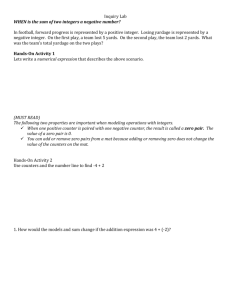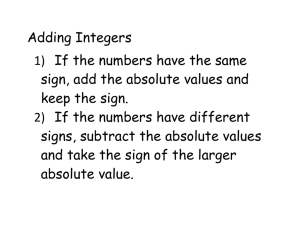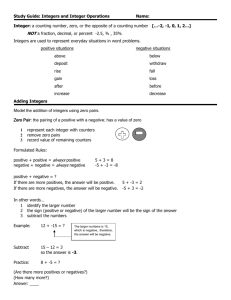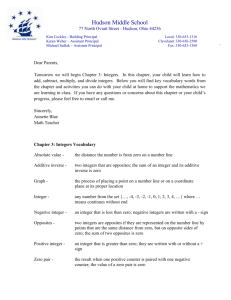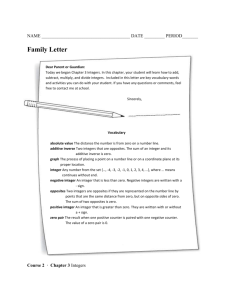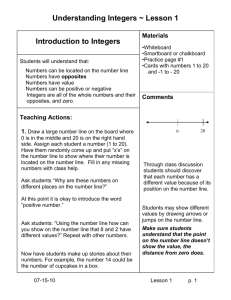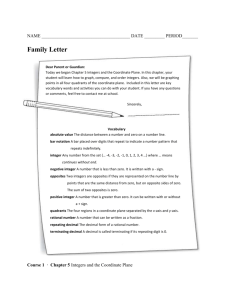The Number System
advertisement
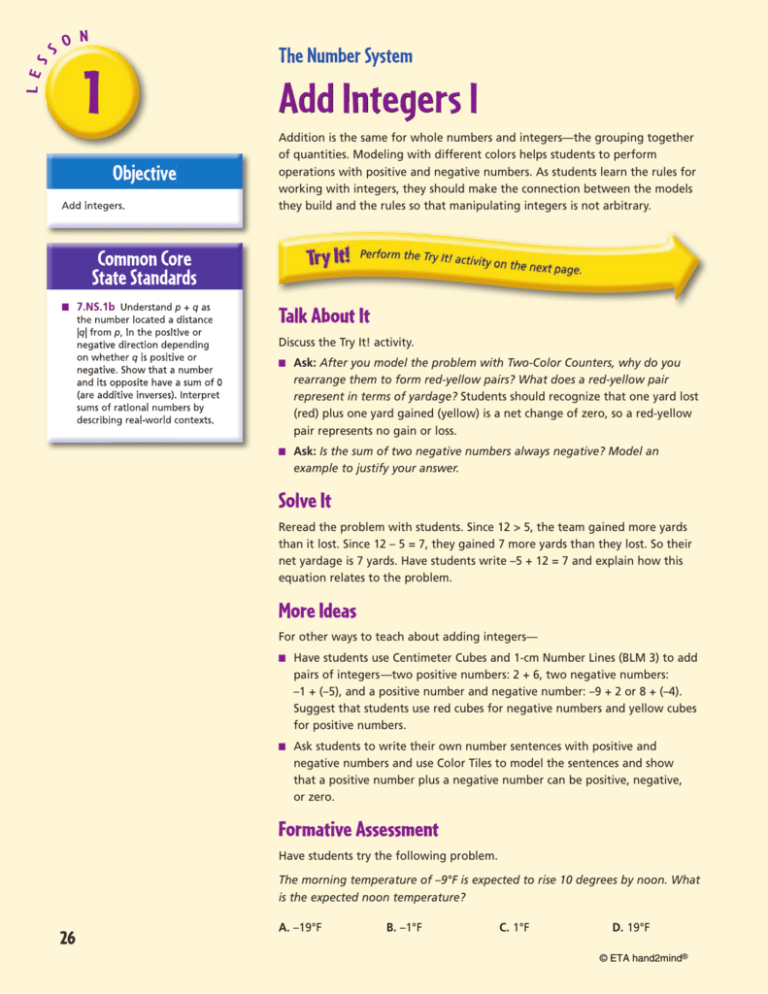
The Number System 1 Add Integers I Objective Addition is the same for whole numbers and integers—the grouping together of quantities. Modeling with different colors helps students to perform operations with positive and negative numbers. As students learn the rules for working with integers, they should make the connection between the models they build and the rules so that manipulating integers is not arbitrary. Common Core State Standards ■ 7.NS.1b Talk About It Discuss the Try It! activity. ■ Ask: After you model the problem with Two-Color Counters, why do you rearrange them to form red-yellow pairs? What does a red-yellow pair represent in terms of yardage? Students should recognize that one yard lost (red) plus one yard gained (yellow) is a net change of zero, so a red-yellow pair represents no gain or loss. ■ Ask: Is the sum of two negative numbers always negative? Model an example to justify your answer. Solve It Reread the problem with students. Since 12 > 5, the team gained more yards than it lost. Since 12 – 5 = 7, they gained 7 more yards than they lost. So their net yardage is 7 yards. Have students write –5 + 12 = 7 and explain how this equation relates to the problem. More Ideas For other ways to teach about adding integers— ■ Have students use Centimeter Cubes and 1-cm Number Lines (BLM 3) to add pairs of integers—two positive numbers: 2 + 6, two negative numbers: –1 + (–5), and a positive number and negative number: –9 + 2 or 8 + (–4). Suggest that students use red cubes for negative numbers and yellow cubes for positive numbers. ■ Ask students to write their own number sentences with positive and negative numbers and use Color Tiles to model the sentences and show that a positive number plus a negative number can be positive, negative, or zero. Formative Assessment Have students try the following problem. The morning temperature of –9°F is expected to rise 10 degrees by noon. What is the expected noon temperature? 26 A. –19°F B. –1°F C. 1°F D. 19°F © ETA hand2mind® Try It! 15 minutes | Pairs Here is a problem about adding integers. A football team lost 5 yards on one play and then gained 12 yards on the next play. What was the team’s net yardage on the two plays? 1. Say: Each red counter represents one yard lost. Each yellow counter represents one yard gained. Place counters to model this problem. Students place 5 red counters and 12 yellow counters. Materials • Two-Color Counters (at least 20 per pair) • 1-cm Number Lines (BLM 3; 1 per pair) The Number System Introduce the problem. Then have students do the activity to solve the problem. Distribute the materials. 2. Say: Move counters so that each red counter is paired with a yellow counter. Ask: What number does each red-yellow pair represent? How many yellow counters are left? Students form 5 pairs, each representing 0. There are 7 yellow counters left, representing a net gain of 7 yards. Students may confuse negative signs with minus signs. Have students write the problem –5 + 12 = 7. Then speak the correct words: negative five (not minus five) plus twelve equals seven. On a number line, show students that –5 and 5 are opposites. They are both 5 units from 0, but in opposite directions. 3. Say: Now use a number line to solve this problem. Starting at 0, draw a segment 5 units to the left. From –5, draw a segment 12 units to the right. Ask: At what number do you end? Students draw the two segments and end at 7. Help students recognize that the overlapping parts of the lines are equivalent to red-yellow pairs of counters. 27 © ETA hand2mind® Lesson 1 Name The Number System Answer Key Use Two-Color Counters to model each addition problem. Make pairs of red and yellow counters. Find the sum. (Check students’ work.) 2. 1. 9 + (–10) –18 + 9 –1 _______________ –9 _______________ Using Two-Color Counters, model each addition problem. Sketch the model. Find the sum. 3. 4. 7 + (–4) 3 _______________ –12 + (–3) –15 _______________ 5. 11 + (–6) 5 ___________ 6. –5 + (–18) –23 ___________ 7. –4 + 13 9 ___________ 8. 9 + (–21) –12 ___________ 9. –6 + (–14) –20 ___________ 10. –3 + (–18) –21 ___________ 24 ___________ 12. 26 + (–50) –24 ___________ 11. 15 + 9 28 Hands-On Standards, Common Core Math Download student pages at hand2mind.com/hosstudent. © ETA hand2mind® Find each sum. Name Key Answer Challenge! Explain how to add two integers if one is a negative number and one is a positive number. When will the sum be negative? When will the sum be positive? © ETA hand2mind® Challenge: (Sample) You actually subtract the numbers, ignoring the signs, and the answer will have the same sign as the number with the greater value (ignoring the negative signs). Download student pages at hand2mind.com/hosstudent. Hands-On Standards, Common Core Math 29 BL M Name 1-cm Number Lines 3 © ETA hand2mind ® 0 0 0 146 BLM 3 1-cm Number Lines Download student pages at hand2mind.com/hosstudent.
